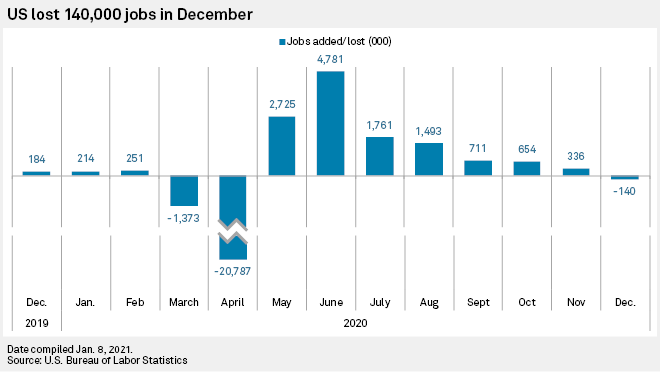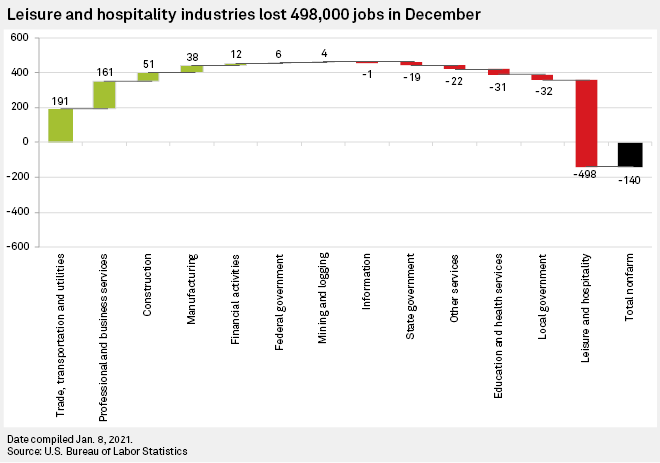S&P Global Offerings
Featured Topics
Featured Products
Events
S&P Global Offerings
Featured Topics
Featured Products
Events
S&P Global Offerings
Featured Topics
Featured Products
Events
Banking & Capital Markets
Economy & Finance
Energy Transition & Sustainability
Technology & Innovation
Podcasts & Newsletters
Banking & Capital Markets
Economy & Finance
Energy Transition & Sustainability
Technology & Innovation
Podcasts & Newsletters
S&P Global Offerings
Featured Topics
Featured Products
Events
8 Jan, 2021
By Evan Fallor
The worst monthly jobs report in eight months shows that the recovery from the COVID-19 pandemic is on pause as coronavirus cases keep setting all-time highs and a $900 billion stimulus package begins to circulate.
Roughly 140,000 jobs were lost in December 2020, according to the U.S. Bureau of Labor Statistics, the first month with jobs in the red since April 2020, when more than 20 million jobs were shed.
The employment performance was well short of the Econoday consensus estimate of 50,000 jobs being added in December 2020, but even if it met expectations, that would have been a marked slowdown from the already weak November 2020 report, in which an upwardly revised 336,000 jobs were added. Rapidly rising coronavirus cases and shutdowns throughout the country as a result in the late fall likely contributed to the layoffs, several economists told S&P Global Market Intelligence.
"140,000 was a huge shock," said Beth Ann Bovino, chief U.S. economist for S&P Global Ratings. She had also projected a roughly 50,000-job addition in December. "A lot of it was driven by leisure and hospitality and quarantining measures, either voluntarily or mandated by states."

Leisure and hospitality shed 498,000 jobs in December, meaning the industry's employment is down by 3.9 million jobs, or 23.2%, since February 2020. The Walt Disney Co., for instance, announced in December 2020 that it expected 32,000 job cuts in the first half of the year from cratering visitor counts at its theme parks. State and local governments shed 50,000 jobs, while educational services saw a 62,000-worker decline.
'The new normal'
The unemployment rate remains at 6.7%, and roughly 55% of the jobs lost in the first two months of the pandemic have now returned, leaving a deficit of 9.8 million jobs versus pre-pandemic levels. U.S. employment likely will not return to the February 2020 high until 2023, Bovino said.
The large spike in reemployment throughout the late spring and summer months was an adjustment to a "new normal," said Michael Hicks, an economics professor at Ball State University. The sectors less affected by the pandemic, such as IT, continued to grow slowly, adding jobs for higher-paid and better-educated workers, he said, adding that more than half of adults with a graduate degree are working at home.
"The new normal is one in which employment flows with the effect of the pandemic," Hicks said in an interview. "As the disease spreads, jobs disappear. The spread of the disease controls employment and GDP in just a few sectors, and as long as it continues to affect them, we'll be at a slow or negative growth economy."
One positive nugget in the otherwise souring report was a decline in the proportion of Americans categorized as permanently unemployed for the first time in eight months, down to 38.9% from 44.0%. The worsening health situation means that jobs growth will be "tepid" in the months ahead, but the latest fiscal relief package should help support incomes in the near term, said Gregory Daco, chief U.S. economist for Oxford Economics. The December 2020 jobs report reveals a U.S. economy that is "chilled but not frozen," he said while forecasting a monthly job creation of roughly 400,000 in 2021 with the economy recovering roughly 6 million jobs as vaccines are distributed.
Dependent on vaccine rollout
The report also does not appear to have changed the Federal Reserve's outlook for the recovery. Fed Vice Chairman Richard Clarida said the overall decline was "disappointing" but not a surprise, given the surge in COVID-19 cases that has prompted more declines in the service sector.
While the next few months will continue to be challenging, the economy could post "very, very impressive growth" later in the year assuming vaccines are widely disseminated.
"The welcome news on the development of several effective vaccines indicates to me that the prospects for the economy in 2021 and beyond have brightened and the downside risk to the outlook has diminished," Clarida said at a Council on Foreign Relations event.

But delays already being experienced with rolling out the vaccine in the U.S. have sparked some concern over when consumer-facing sectors will see customers more comfortable with patronizing their businesses.
Anthony Fauci, the director of the National Institute of Allergy and Infectious Diseases, told NPR on Jan. 7 that "things will get worse as we get into January" as the U.S. set a record number of daily deaths with more than 4,000 that day. The daily death count is expected to rise for weeks, and further shutdowns or partial lockdowns are expected throughout the U.S.
"The current job loss is affected by the pandemic surge," Peter Orazem, an economist at Iowa State University, said in an interview. "If the disease spread ended or slowed with the rollout of the vaccine, we would see a rapid increase in employment. I expect that will show up by the second quarter."
Stimulus effect
One positive factor for the employment picture in the near term is the $900 billion relief package reached by Congress and signed into law by President Donald Trump in late December 2020. That bill provides $150 billion for one-time $600 checks for those earning under $75,000 annually as well as $115 billion in extended emergency unemployment benefits for 11 weeks, including a $300-per-week expanded unemployment benefit for that span.
Orazem said the impact of the stimulus has not yet hit, and that will have an effect on employment in the first quarter, particularly in sectors providing necessities.
Economists have looked to the possibility of increased one-time stimulus checks to the lowest earners, who have a higher propensity to spend cash, as a means of more effectively stimulating the economy. With Democrats taking control of both houses of Congress and the White House, the likelihood of more one-time checks increases.
"This shocking headline number will likely give more power to the Biden administration to be able to ask for more stimulus when Biden is inaugurated," Bovino said.
As early evidence of the benefits of an injection of direct payments, TGI Fridays CEO Ray Blanchette told Bloomberg on Jan. 8 that the restaurant chain is doing "much much better for the last couple of days ... as soon as those stimulus checks hit."
"Talk about pent-up demand," Blanchette said.
